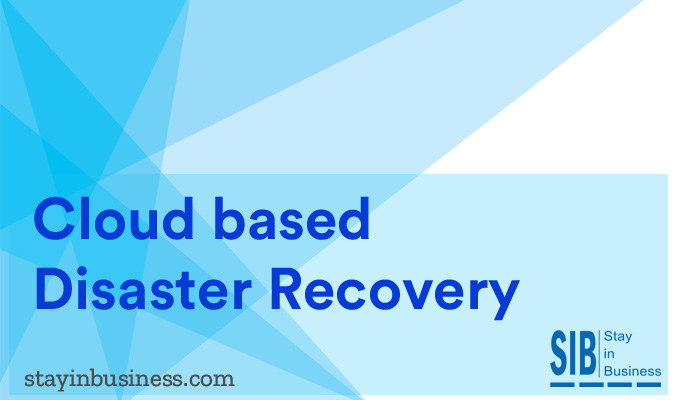
More and more organizations are taking advantage of the innumerable benefits of cloud based disaster recovery and doing away with archaic strategies such as off-site production sites and backup tapes. Within a short span of time, the cloud based disaster recovery market has become extremely competitive with many vendors to choose from, who are forced to provide better quality service at lower prices.
What is Cloud Based Disaster Recovery?
Cloud based disaster recovery facilitates operational fail-over during emergencies by backing up and restoring electronic data in a cloud based environment.
The Importance of Cloud Based Disaster Recovery
- Saves time by backing up data through automation
- Minimizes downtime to negligible levels during disasters
- Service is reliable, thanks to the availability of redundant infrastructure
- Seamless and automated fail-over and fail-back processes
- Resolves power outage induced data unavailability through remotely available and reliable power sources
- Guaranteed service delivery from vendors on up-time, RTO, RPO and other parameters through explicitly detailed SLAs
- Customized solutions that segregate systems and applications across public, private and hybrid cloud environments based on requirements
- All maintenance and testing needs are handled by the vendor
Benefits of Cloud Based Disaster Recovery
Value for Money
Cloud based disaster recovery solutions are budget friendly and today, even small and medium enterprises can make their operations safe and secure by availing these services. Entrepreneurs are opting for virtual servers instead of expensive offsite production centers. Business data replication in real time on cloud based platforms has brought down disaster recovery overheads while processes such as backing up and restoring data have become faster than ever. The cloud based disaster recovery model seamlessly combines improved resiliency and financial feasibility.
Simplified Disaster Recovery
All cloud based disaster recovery services are collectively referred to as Disaster Recovery as a Service (DRaaS). IT managers using DRaaS today have the luxury of devoting time to important tasks which they would otherwise have to spend on updating existing DR plans with industry best practices. This is an outsourced activity today and a lot more economical than before.
More Efficient Disaster Recovery
Cloud Based Disaster Recovery has improved organization RTO and RPO values, which is good for business. Procedural efficiency has also seen a turnaround, even in the case of multiple production facilities, as data is replicated on the cloud. When disaster strikes and entire production facilities go down, employees can access virtual desktops on cloud based platforms and restore operations within the RTO and RPO values.
Virtual servers don’t depend on local hardware. So, with cloud based disaster recovery, applications, operating systems, patches, data and other entities can be shared between locations without having to reload each server component. This implies enhanced DR efficiency across all business operations.
Flexible Pricing
Cloud based disaster recovery services are subscription based. So you only have to pay for the features that you use. Additional features or those that are no longer required can be included in or removed from your subscription package as and when necessitated by business needs.
With cloud based disaster recovery, you can achieve state of the art resiliency at a fraction of what traditional Disaster Recovery solutions would cost. And your organization can utilize all these savings to improve critical, revenue generating business processes.
Security in Cloud Based Disaster Recovery
Safeguarding assets is a prime concern in any business undertaking and your firm must thoroughly evaluate a cloud based disaster recovery vendor’s security strategies before signing up. Most well established cloud based DR vendors with time tested credentials invest heavily on security infrastructure. Access is usually restricted to two stage authentication involving a username, password and a one-time password.
Be sure to thoroughly evaluate the feasibility and relevance of your cloud based Disaster Recovery vendor’s security capabilities based on the risks prevalent in your organization’s operational terrain.
Conclusion
Every cloud based disaster recovery solution has its share of drawbacks and it would be wise for your organization to carefully weigh the pros and cons of each solution before signing up with a particular vendor.
Disasters
[carousel id=’1780′ items=’4′ items_desktop=’3′ margin_right=’5′ navigation=’false’] [item img_link=”https://www.stayinbusiness.com/wp-content/uploads/2016/02/Chemical-Spills-Discharges.jpg” href=”https://www.stayinbusiness.com/resource/disaster-recovery/chemical-spills-and-discharges/”][item img_link=”https://www.stayinbusiness.com/wp-content/uploads/2016/02/Riots-Public-Disturbances.jpg” href=”https://www.stayinbusiness.com/resource/disaster-recovery/riots-and-public-disturbances/”][item img_link=”https://www.stayinbusiness.com/wp-content/uploads/2016/02/Terrorism.jpg” href=”https://www.stayinbusiness.com/resource/disaster-recovery/terrorism/”] [item img_link=”https://www.stayinbusiness.com/wp-content/uploads/2016/02/worst-product-recall.jpg” href=”https://www.stayinbusiness.com/resource/disaster-recovery/product-recall/”] [/carousel]

